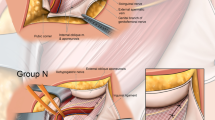Abstract
Background
Incarcerated inguinal hernia may be treated effectively by recent surgical techniques with a low rate of complications, but it is unclear whether quality of life is improved by elective inguinal hernia repair. Therefore we investigated the quality of life before and after inguinal hernia repair using plug and patch technique.
Patients and methods
Quality of life was prospectively assessed in 123 patients before and 3 months after plug and patch inguinal hernia repair using the Short Form 36 questionaire and a visual analog scale. All patients complained preoperatively of pain associated with the clinical findings of inguinal hernia (visual analog scale: reduced quality of life 6.8±2.7; reduced daily activity: 5.5±2.6). Clinical characteristics (operation times, in-hospital stay, complications, need for pain medication) were documented. Inclusion criteria were patients with symptomatic inguinal hernia, scheduled for elective unilateral inguinal hernia repair by plug and patch technique.
Results
There were no major in-hospital complications. At 3 months no recurrences of inguinal hernia or late onset complications were observed; seven patients complained of dumbness, and eight felt pressure at the operation site with a tendency for resolving pain within this time. At 3 months patients had a significantly improved quality of life regarding freedom from pain, vitality, and physical activity compared to preoperatively.
Conclusions
Plug and patch repair of unilateral inguinal hernia improves quality of life with a very low rate of procedural complications. Regarding freedom from pain, vitality, and physical activity there is significant improvement as compared to preoperatively. Therefore inguinal hernia repair should be intended in all elective cases and plug and patch repair appears as an excellent technique to improve quality of life.

Similar content being viewed by others
References
Arlt G (1995) Quality control in inguinal hernia surgery: In: Schumpelick V, Wantz GE (eds) Inguinal hernia repair. Expert Meeting on Hernia Surgery, St Moritz, 1994. Karger, Basle, pp 303–305
Gallegos NC, Dawson J, Jarvis M, Hobsley M (1991) Risk of strangulation in groin hernias. Br J Surg 78:1171–1173
Kingsnorth AN (1995) Epidemiology, pathogenesis and natural history of inguinal hernia. In: Schumpelick V, Wantz GE (eds) Inguinal hernia repair. Karger, Basle, pp 2–5
Kulah B, Kulacoglu H, Oruc T, Duzgun AP, Moran M (2001) Presentation and outcome of incarcerated external hernias in adults. Am J Surg 181:101–104
Kuthe A, Mainik F, Flade-Kuthe (2001) TEP: Vorgehen bei incarcerierter Leistenhernie. Presentation at the Foundation Symposium of the German Hernia Society, Aachen
Bitzer EM, Dörning H, Schwartz FW (2000) Der Erfolg von Leistenbruchoperationen in der Routineversorgung aus der Sicht der Patienten. Chirurg 71:829–834
Lawrence K, McWhinnie D, Jenkinson C, Coulter A (1997) Quality of life in patients undergoing inguinal hernia repair. Ann R Coll Surg Engl 79:40–45
Bullinger M, Kirchberger I, Ware J (1995) Der deutsche SF-36 Health Survey. Z Gesundheitswissenschaft 3:21–25
Zieren J, Zieren HU, Jacobi CA, Müller JM (1997) Die Plug-und-Patch-Reparation zur Versorgung der Leistenhernie des Erwachsenen. Zentralbl Chir 122:545–550
Amid PK, Shulman AG, Lichtenstein IL (1994) A five step technique for local anesthesia in inguinal hernia repair. Chirurg 65:388–390
Bay-Nielsen M, Perkins FM, Kehlet H (2001) Pain and functional impairment 1 year after inguinal herniorrhaphy: a nationwide questionnaire study. Ann Surg 233:1–7
Poobalan AS, Bruce J, King PM, Chambers WA, Krukowski ZH, Smith WCS (2001) Chronic pain and quality of life following open inguinal hernia repair. Br J Surg 88:1122–1126
Author information
Authors and Affiliations
Corresponding author
Rights and permissions
About this article
Cite this article
Zieren, J., Küpper, F., Paul, M. et al. Inguinal hernia: obligatory indication for elective surgery?. Langenbecks Arch Surg 387, 417–420 (2003). https://doi.org/10.1007/s00423-002-0341-7
Received:
Accepted:
Published:
Issue Date:
DOI: https://doi.org/10.1007/s00423-002-0341-7




